Author: Adam Simmons
Last updated: June 24th 2024
Our key up to date recommendations are given in the table below, grouped by size.
As an Amazon Associate I earn from qualifying purchases made using “Buy” buttons on this page. Where possible, you’ll be redirected to your nearest store. Further information on supporting our work.
BenQ EX240 (23.8″ 165Hz IPS, 1920 x 1080)
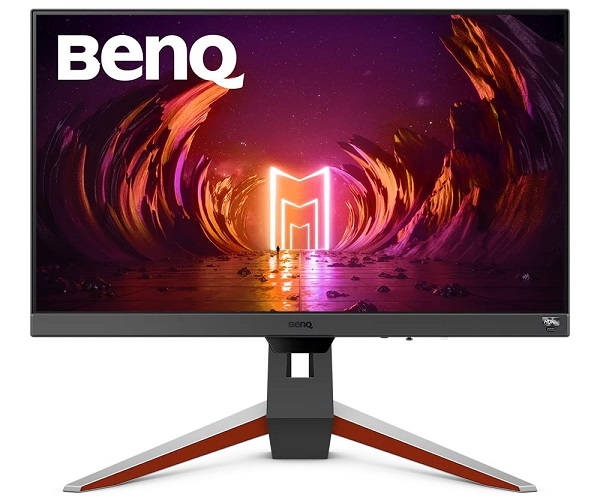
BenQ EX240
- 23.8″ IPS-type panel (165Hz)
- Medium matte anti-glare screen surface
- 1920 x 1080 (Full HD or 1080p)
- 1000:1 contrast ratio
- Basic HDR10 support
- Flicker-free WLED backlight (~400 cd/m² peak luminance, ~sRGB gamut)
- 3.5mm headphone jack, 2 USB 3.0 ports (plus upstream), 2 HDMI 2.0 ports, DP 1.2a
- Tilt, swivel and height adjustment with VESA 100 support
- 2 x 2.5W speakers
Why choose this monitor:
The BenQ EX240 features an IPS-type panel with ~sRGB colour gamut and flexible gamma settings to allow some fine-tuning. The panel type allows the screen to deliver ‘rich and natural’ colours, with saturation levels appropriately maintained throughout the screen. As with other IPS-type panels, contrast isn’t a key strength – so don’t expect a deep and ‘atmospheric’ look in a dark room. But in brighter room lighting its weaknesses in this respect are less apparent. This model offers basic HDR10 support, giving a different look to things with 10-bit colour processing offered. It doesn’t have a high enough brightness level, wide colour gamut or local dimming for a true HDR experience, however. This is a solid budget offering with a Full HD resolution, matching a lot of video content well. Pixel responsiveness is also strong with flexible overdrive settings, whilst the monitor supports multiple refresh rates including 24Hz (24p) all the way up to 165Hz. The integrated TreVolo speakers provide a richer sound than many integrated speakers, whilst flexible and well-tuned Low Blue Light (LBL) settings are included to promote a more relaxing viewing experience.
Further reading:
A thread focusing on this model in comparison to some others (including EX2510S)
AOC C24G1/C24G1A (23.6″ 144Hz/165Hz curved VA, 1920 x 1080)
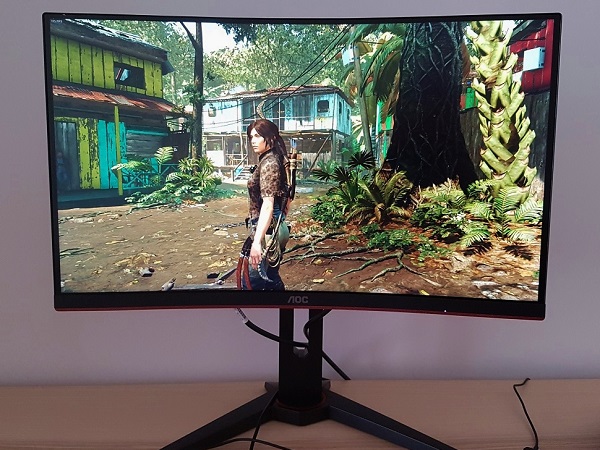
AOC C24G1/C24G1A
- 23.6″ 144Hz VA panel (TPV TPM236WF1-HP02 Samsung SVA or similar)
- 1500R curve
- Light matte anti-glare screen surface
- 1920 x 1080 (Full HD or 1080p)
- 3000:1 contrast ratio
- Flicker-free WLED backlight (250 cd/m² peak luminance, ~sRGB gamut)
- 2 HDMI 1.4 ports, DP 1.2a, VGA, 3.5mm headphone jack
- Tilt, height and swivel stand adjustment with VESA 100 support
Why choose this monitor:
The AOC C24G1(A) features a VA panel with ~sRGB colour gamut, delivering quite a natural-looking image with less saturation than wider gamut options. The contrast is strong, helping achieve a more atmospheric look to dark scenes and helping bright elements stand out well against darker surroundings. The 1500R curve helps draw you into the experience a bit, but wasn’t something we found unnatural – given the relatively small screen size we didn’t find it changed the overall viewing experience too dramatically, really. The monitor lacks HDR support but is an affordable Full HD option which matches up well with most video content. The pixel responsiveness is better than average for the panel type, too, handling movie content well. With only minor weaknesses that most users will not find distracting or necessarily even notice. A fairly well-implemented strobe backlight setting (MBR) is also included, which can provide an edge in motion clarity that some may appreciate. Flexible Low Blue Light (LBL) settings are also included to aid relaxing viewing.
Prefer flat screens? Consider the LG 24GQ50F as an alternative.
Further reading:
Philips 288E2UAE/288E2E (28″ 60Hz IPS, 3840 x 2160)
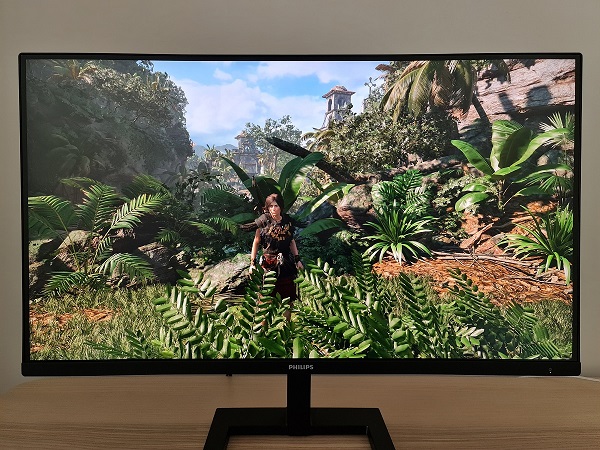
Philips 288E2UAE (288E2E)
- 28″ 60Hz IPS panel (Innolux M280DCA-E3B AAS IPS-type)
- Light to very light matte anti-glare screen surface
- 3840 x 2160 (‘4K’ UHD)
- 1000:1 contrast ratio
- Flicker-free WLED backlight (300 cd/m² peak luminance, ~87% DCI-P3 gamut)
- DP 1.4, HDMI 2.0 (x2 for ‘E2E’), 3.5mm audio output, 4 USB 3.2 ports (‘E2UAE’ only)
- Tilt and height adjustment with VESA 100 support
- 2 x 3W speakers (‘E2UAE’ only)
Why choose this monitor:
The Philips 288E2E (288E2UAE) features a 28″ ‘4K’ UHD IPS-type panel. This offers strong clarity for ‘4K’ video content. Whilst also handling Full HD content well, with the screen running at its native resolution. The screen size provides a decent level of immersion from a normal viewing position. Meanwhile, the panel type keeps colours nice and consistent, rich throughout the screen. The colour gamut provides a good dose of extra vibrancy without the heavy oversaturation of even wider gamuts. The light to very matte screen surface helps the screen maintain its clarity and vibrancy potential better than ‘stronger’ screen surfaces, too. Contrast is not strong enough for a deep and atmospheric experience in a dark room, but works well in brighter room lighting and is a touch beyond what some IPS-type models provide. There’s no HDR support and the brightness adjustment range is quite limited, but will still be sufficient for most users. Pixel responsiveness is sufficient for a good experience when viewing ~23-30fps or 60fps content, whilst flexible Low Blue Light (LBL) settings promote relaxing viewing. The unit we reviewed was very well calibrated in terms of gamma and colour temperature for our preferred ‘2.2’ and 6500K targets, respectively.
In some regions a 288E2A variant is available with tilt-only stand, 2 HDMI 2.0 ports, an audio input and speakers but no USB ports. We’d recommend considering this if it’s available at an agreeable price and the extra features aren’t important to you.
Further reading:
An article exploring the ‘4K’ UHD resolution on screen of this size
AOC Q27G3XMN(/BK) (27″ 180Hz VA, 2560 x 1440)
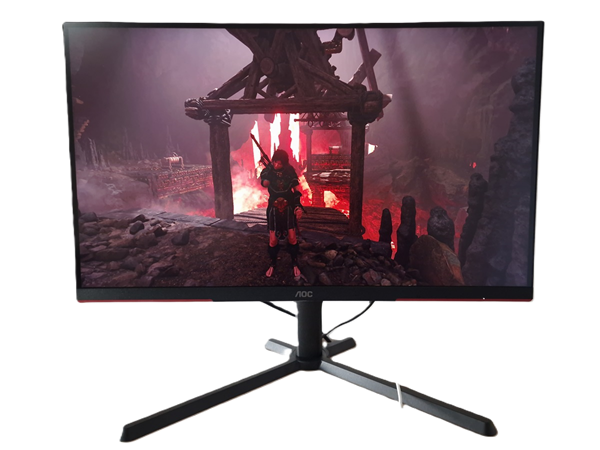
AOC Q27G3XMN(/BK)
- 27″ VA panel (CSOT SG2701G02-2 with custom backlight)
- Light to very light matte anti-glare screen surface
- 2560 x 1440 (QHD or 1440p)
- 4000:1 contrast ratio
- VESA DisplayHDR 1000
- PWM-free (flicker-free) WLED backlight (567 cd/m² SDR peak luminance measured, ~96% DCI-P3 gamut)
- 2 HDMI 2.0 ports, DP 1.4, 3.5mm headphone jack
- Screen is fully adjustable with 100 x 100mm VESA support
Why choose this monitor:
The AOC Q27G3XMN(/BK) provides a dynamic HDR experience via a 336-zone ‘Mini LED’ backlight, combined with a VA panel offering strong native contrast. Good brightness levels can be provided (1374 cd/m² HDR peak, measured), including where bright shades dominate. Local dimming can also be used under SDR for a nice edge in contrast outside of HDR as well, with adjustable brightness. The VA panel can’t keep up with IPS or OLED panels when it comes to colour consistency, but is decent for a VA model and is combined with quite a generous gamut for good overall vibrancy. An sRGB emulation mode is offered (non-BK model only, but GPU level alternatives exist either way). Pixel responsiveness is reasonable for the panel type, providing a competent and low-overshoot experience for video content of any frame rate. Flexible Low Blue Light (LBL) settings are also included to aid relaxing viewing.
Further reading:
MSI MAG 323UPF (32″ 160Hz IPS, 3840 x 2160)
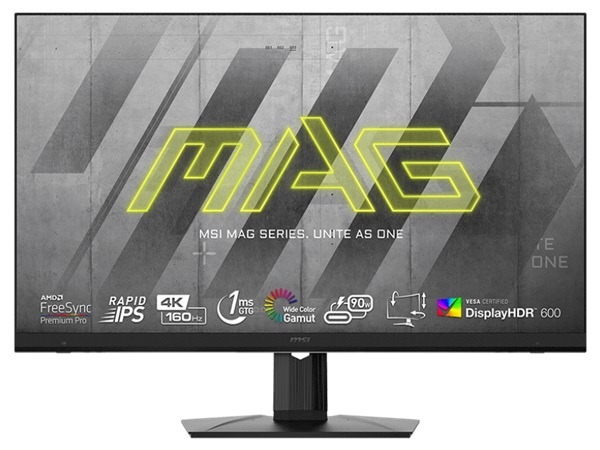
MSI MAG 323UPF
- 32″ IPS panel (AUO AHVA)
- Light to very light matte anti-glare screen surface
- 3840 x 2160 (‘4K’ UHD)
- 1000:1 contrast ratio
- VESA DisplayHDR 600
- Flicker-free WLED backlight (440 cd/m² SDR peak luminance, ~95% DCI-P3 gamut)
- 2 HDMI 2.1 ports, DP 1.4 (with DSC), USB-C (90W PD, DP Alt Mode, upstream data), 3 USB 2.0 ports (plus Type-B upstream), 3.5mm headphone jack
- Tilt, swivel and height adjustment. 100 x 100mm VESA mounting supported
Why choose this monitor:
The MSI MAG 323UPF features a 32″ IPS-type panel with 3840 x 2160 (‘4K’ UHD) resolution. Combined with a generous though not extreme colour gamut (~95% DCI-P3 coverage), the monitor provides quite an extra hit of extra vibrancy without the heavily ‘overdone’ look for sRGB content that an even wider gamut provides. An sRGB emulation mode is included for a more toned down appearance. The resolution and screen size combination provides an immersive ‘4K’ UHD experience, with excellent detail for suitably high resolution video content. The light to very light matte screen surface offers strong preservation of the clarity and vibrancy, with a smoother finish than some offerings, preventing strong graininess when viewing lighter content. VESA DisplayHDR 600 support is included, allowing the monitor to put its decent DCI-P3 gamut to good use and pulse the luminance up to higher levels (up to ~700 cd/m² reliably recorded) with basic local dimming for a situational edge in contrast. This is still only a basic HDR level, not necessitating complex local dimming or a very high luminance by HDR standards. The monitor also provides competent pixel responsiveness for movie content of all frame rates. Viewing comfort is promoted with ‘Low Blue Light Hardware Solution’ certification by TÜV Rheinland (shifted less energetic blue light peak) and additional Low Blue Light (LBL) settings that give a warmer look to the image.
If you require lower minimum brightness (~52 cd/m² rather than ~130 cd/m²), consider the Gigabyte M32U.
Further reading:
Philips 328E1CA (31.5″ 60Hz curved VA, 3840 x 2160)
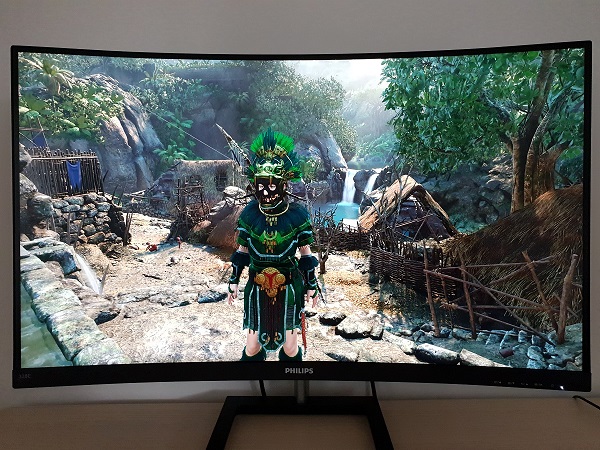
Philips 328E1CA
- 31.5″ 60Hz VA panel (TPV TPM315WR1-FP01.S Samsung SVA or similar)
- 1500R curve
- Light matte anti-glare screen surface
- 3840 x 2160 (‘4K’ UHD)
- 2500:1 contrast ratio
- Flicker-free WLED backlight (250 cd/m² peak luminance [>300 cd/m² measured], ~122% sRGB gamut)
- 2 HDMI 2.0 ports, DP 1.2a, 3.5mm audio input, 3.5mm audio output
- Tilt adjustment with VESA 100 support
- 2 x 3W speakers
Why choose this monitor:
The Philips 328E1CA provides an engrossing experience from its 31.5″ screen, with a 1500R curve drawing you in a bit. We didn’t find this unnatural when watching video content. The high pixel density provides good detail levels to ‘4K’ content, whilst presenting Full HD content well with the screen at its native resolution. The colour gamut extends a bit beyond sRGB, but not by an extreme amount. Helping inject a bit of extra vibrancy without a strongly oversaturated appearance. The relatively strong contrast, meanwhile, aids the atmospheric look to darker content. Whilst helping bright elements stand out well against darker surroundings. As usual for a VA model there are some pixel response time weaknesses, but this model is quite well-tuned in that respect and provides a decent experience for lower and higher refresh rate content. Flexible Low Blue Light (LBL) settings are also included to aid relaxing viewing.
Further reading:
A post summarising our thoughts on this model in the context of some alternatives
Philips Evnia 34M2C8600 (34″ 175Hz curved QD-OLED, 3440 x 1440)
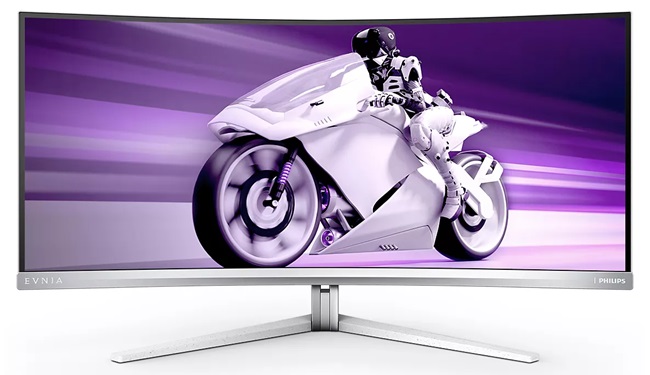
Philips Evnia 34M2C8600
- 34.18″ 175Hz OLED panel (Samsung Display QD-OLED)
- 1800R curve
- Glossy screen surface with anti-reflective treatment
- 3440 x 1440 (UWQHD – 21:9 ultrawide)
- 1m:1 contrast ratio
- VESA DisplayHDR True Black 400
- Flicker-free QD-OLED (250 cd/m² SDR peak luminance, ~100% DCI-P3 gamut)
- 2 HDMI 2.0 ports, DP 1.4, USB-C (90W PD, DP Alt Mode, upstream data), 4 USB 3.2 Gen 1 ports (plus Type-B upstream) and a 3.5mm audio output
- Tilt, swivel and height adjustment with VESA 100 support
- 2 x 5W speakers
Why choose this monitor:
The Philips Evnia 34M2C8600 provides a 3440 x 1440 resolution and 21:9 aspect ratio, giving a screen-filling experience for supported video content. A moderate curve is included to help draw you in a bit and add a bit of immersion, something that tends to feel very natural on a screen of this size. The generous colour gamut combined with the exceptional colour consistency of the OLED panel provides high vibrancy throughout the screen. Meanwhile, the per-pixel illumination delivers exceptional depth and atmosphere to dark shades in dimmer lighting and helps add depth and an inkiness to medium shades as well. The monitor provides a highly dynamic HDR experience, with per-pixel illumination and bursts of brightness up to 1000 cd/m². This is complemented by generous DCI-P3 coverage and 10-bit colour processing to deliver a vivid and suitably varied look. Pixel responsiveness is exceptional, without visible weaknesses due to sluggish transitions or overshoot artifacts for any frame rate of content. The ‘balanced spectral output’ coupled with Low Blue Light (LBL) settings help promote a more relaxing viewing experience, too, as can the integrated ‘Ambiglow’ lighting solution which can act as a bias light.
Further reading:
Our AW3423DW review, based on the same panel with many similarities
BenQ EW3880R (37.5″ 60Hz curved IPS, 3840 x 1600)
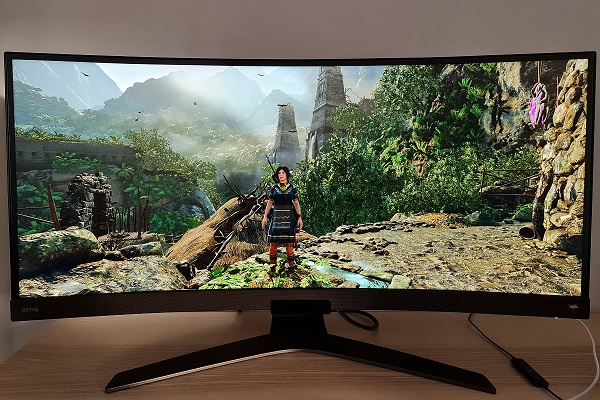
BenQ EW3880R
- 37.5″ 60Hz IPS panel (LG Display LM375QW2-SSB1 IPS)
- 2300R curve
- Light to very light matte anti-glare screen surface
- 3840 x 1600 (UWQHD+ – 21:9 ultrawide)
- 1000:1 contrast ratio
- Basic HDR10 support
- Flicker-free WLED backlight (230 cd/m² peak luminance, ~94% DCI-P3 gamut)
- 2 HDMI 2.0 ports, DP 1.4, USB-C (60W PD, DP Alt Mode, upstream data), 2 USB 3.0 ports, 3.5mm headphone jack
- Tilt, swivel and height adjustment with VESA 100 support
- 2 x 3W speakers plus 8W integrated subwoofer
Why choose this monitor:
The BenQ EW3880R provides a 3840 x 1600 resolution and 21:9 aspect ratio, giving an exceptionally immersive experience with all of the screen space used for supported video material. The curve adds a little extra depth to the experience without feeling unnatural and is something most will readily adapt to. The generous colour gamut (~94% DCI-P3) provides a good hit of extra vibrancy, with a ‘Rec.709’ sRGB emulation setting for those preferring a more toned down appearance. The IPS panel delivers excellent colour consistency and a strong viewing angle performance, keeping shades rich and evenly saturated throughout the screen. The light to very light matte screen surface with smooth finish gives brighter shades a smooth appearance without clear layering and is good at aiding the clarity and vibrancy potential. The monitor will also respond to HDR10 content, providing a basic experience there with the colour gamut and 10-bit colour processing put to good use. Other aspects of note include well-balanced Low Blue Light (LBL) settings, an IR remote for quick and intuitive OSD navigation and a rich and powerful integrated sound system.
Further reading:
LG C4 OLED (42″ 144Hz OLED, 3840 x 2160)

LG C4 OLED
- 42″ OLED panel (LG Display WOLED)
- Glossy screen surface with anti-reflective treatment
- 3840 x 2160 (‘4K’ UHD)
- ‘Infinite’ contrast ratio
- HDR10, Dolby Vision & HLG support
- Flicker-free OLED (~800 cd/m² HDR peak luminance, ~98% DCI-P3 gamut)
- 4 HDMI 2.1 ports, 3 USB 2.0 ports, optical audio out, ethernet LAN, 2 RF In, CI Slot, S/PDIF plus WiFi and Bluetooth connectivity
- Screen has a fixed (non-adjustable) stand with 300 x 200mm VESA support
- 2 x 10W speakers
Why choose this monitor:
The LG C4 OLED (OLED42C4PUA with regional variations) offers a 3840 x 2160 (‘4K’ UHD) resolution, providing a highly immersive experience. The resolution and pixel density ensures good detail levels are maintained for suitable video content, even when spread across such a large screen. The strong DCI-P3 coverage and consistency of the OLED panel provides good (and even) vibrancy levels at all points. Per-pixel illumination, meanwhile, ensures exceptional depth and atmosphere to dark shades in dimmer lighting. With superior inkiness given to medium shades as well. For HDR the screen provides multiple formats and puts this per-pixel illumination and strong DCI-P3 coverage to good use alongside 10-bit+ colour processing and a peak luminance of up to ~800 cd/m². Pixel responsiveness is exceptional, without visible weaknesses due to slower than ideal pixel responses or overshoot for any content frame rate. Other aspects of note include hardware calibration capability, ‘Smart TV’ functionality (as this is a TV rather than monitor) and a remote for convenient operation of the very comprehensive menu systems.
Further reading:
This list is heavily condensed; look out for the recommended or approved badge in our reviews as well. You can sort our reviews by badge status and various other features there.
For movie watching it’s often desirable to have a screen with strong contrast. The extra depth to dark shades and superior atmosphere that can deliver, especially in dimmer lighting conditions, can be a key part of the experience for some movie-lovers. When it comes to LCD panels, that’s the domain of the VA panel with static contrast typically around 3 times as high as other LCD panel types. OLED technology is far from prolific in the monitor market. But it’s even stronger in that respect, with a practically infinite contrast ratio due to their per-pixel illumination. Depending on the content you watch or your preferences, IPS panels may be more attractive than VA panels for video content – and there are ways to counteract the weaker contrast in dimmer lighting conditions. Anime, cartoons and other animated content really highlight the relative strengths of IPS-type panels when it comes to colour consistency – a key concept explored in our panel types article. These superior colour reproduction characteristics can also be appreciated for content set in the real world, with richness and saturation better maintained throughout the screen.
Some video content, including on streaming platforms such as Netflix or Amazon Prime, is mastered in the ‘4K’ UHD resolution. So it can be attractive to use a monitor that matches this resolution and therefore takes full advantage of this content. An increased pixel density improves the detail and clarity of suitably high-resolution content such as this. HDR (High Dynamic Range) is also becoming more readily available, with the HDR10 standard being the most widely supported. Monitors which support HDR are fairly widespread now, although many offer only a very basic and limited HDR experience. Sometimes the experience is so compromised it’s better to stick to ordinary SDR (Standard Dynamic Range), other times there is a genuine enhancement to the experience under HDR. 10-bit colour reproduction, a wide colour gamut (~DCI-P3+) used appropriately and improved contrast due to local dimming and a powerful backlight are key benefits of a good HDR experience. VESA DisplayHDR’s certification system will give a broad idea of the relative HDR capabilities of a display, but even within each ‘tier’ there’s quite a bit of variation between how good the actual HDR performance is.

VESA DisplayHDR
For extended boxset binging, watching long movies viewing comfort is important. All models featured here have flicker-free backlights and many offer LBL (Low Blue Light) settings. Although viewing comfort has many facets and is a very subjective area. Responsiveness is also something to consider, not just for viewing comfort but general enjoyment of the content. It’s less of a factor here than it is for gaming monitors, however. The frame rate of most video content on platforms including Netflix, Amazon Prime Video and YouTube is ~24 – 30fps. With 60fps being the upper limit in most cases, usually reserved for certain content on platforms such as YouTube and TikTok. Some models may show obvious weaknesses when gaming at high refresh rates and frame rates, due to slower than optimal pixel responses. But might deal with movie content just fine. And because you don’t interact with the content as you do when gaming, input lag or the overall ‘connected feel’ of the monitor isn’t something you need to worry about. High refresh rates are therefore much less important. In theory a high refresh rate could slightly reduce some instances of juddering. 24fps, 30fps and 60fps all divide evenly into 120Hz and 240Hz, for example. But the frame rate is the main barrier to fluidity and when viewing 24 – 30fps content on a monitor of any refresh rate you can expect moderate juddering to persist.
